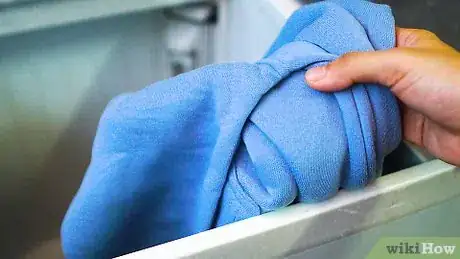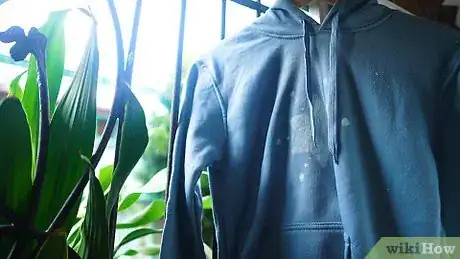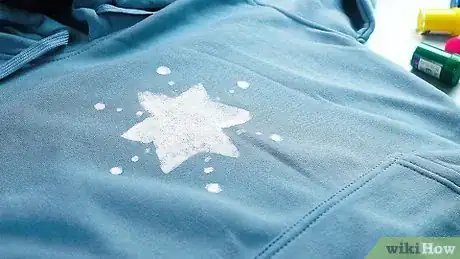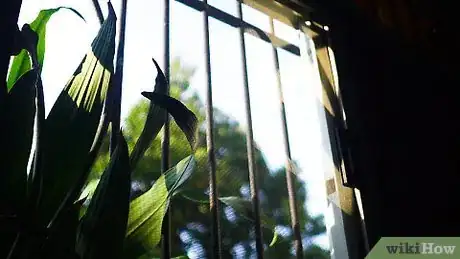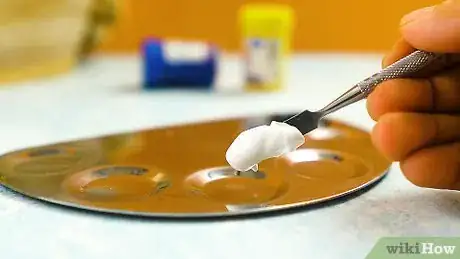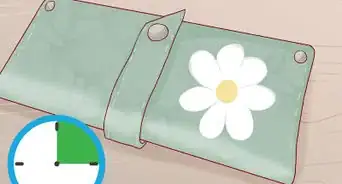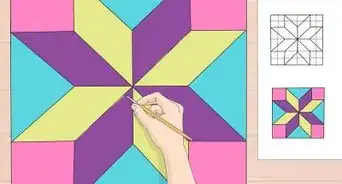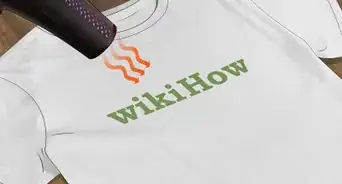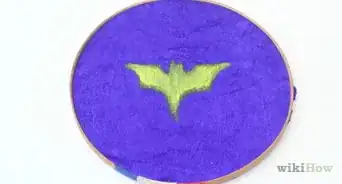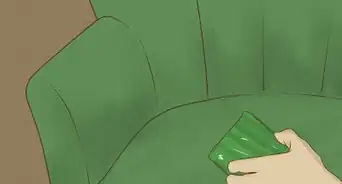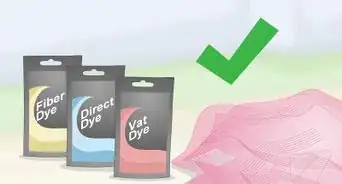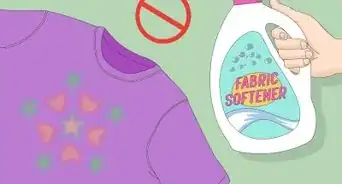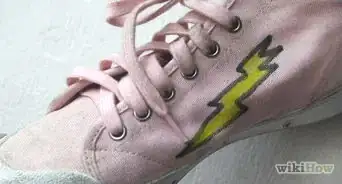This article was co-authored by wikiHow staff writer, Eric McClure. Eric McClure is an editing fellow at wikiHow where he has been editing, researching, and creating content since 2019. A former educator and poet, his work has appeared in Carcinogenic Poetry, Shot Glass Journal, Prairie Margins, and The Rusty Nail. His digital chapbook, The Internet, was also published in TL;DR Magazine. He was the winner of the Paul Carroll award for outstanding achievement in creative writing in 2014, and he was a featured reader at the Poetry Foundation’s Open Door Reading Series in 2015. Eric holds a BA in English from the University of Illinois at Chicago, and an MEd in secondary education from DePaul University.
The wikiHow Video Team also followed the article's instructions and verified that they work.
This article has been viewed 29,511 times.
Learn more...
Fabric paint is an excellent way to create custom clothing with beautiful artwork and handmade designs. Unfortunately, it takes 12-36 hours to dry depending on how much you’ve used. This is especially a pain if you want to apply multiple layers of paint for more elaborate designs. To decrease the drying time, use a combination of heat and moving air. You can also use a fast-drying fabric paint, fabric ink, or acrylic paint mixed with fabric medium for a faster-drying alternative to standard fabric paint.
Steps
Keeping Your Clothes Warm
-
1Tumble-dry your fabric before painting it to start drying the paint early. Before using fabric paint, you have to wash and dry your fabric to avoid shrinking in the future. While many people line dry their fabrics before using their fabric paint, your paint will dry more quickly if you tumble-dry the fabric on high heat. As soon as your fabric is done drying in the machine, begin painting immediately.
- Fabric paint dries faster when it is exposed to heat. Painting on a warm surface will start the drying process while you’re still creating your design.
Tip: If the paint is flat, the color is even, and the fabric behind the area you painted doesn’t feel wet, your paint is dry. You can also tap the paint gently with a small cotton swab to see if some of the color comes off.
-
2Dry your fabric in the sun to warm the fibers as the paint sets. Once you’re done painting, find a sunny window in your home. Set your fabric in front of the window so that the fabric is exposed to the sunlight. The heat from the sun will naturally warm your fabric without overheating it.
- Hanging your fabric vertically on a hanger and curtain rod is a great way to speed this process up.
Advertisement -
3Keep the drying area warm by turning up the heat or using a space heater. Setting the thermostat to 75–85 °F (24–29 °C) will help your fabric dry quicker. If you want to heat the fabric further, set up a space heater in the room where the fabric is drying. Set the space heater on low and move flammable materials at least 3 feet (0.91 m) away from the heater as you dry the fabric.
- If it gets hotter than 100 °F (38 °C), your paint may actually melt as it dries, which can ruin your design. High heat is good for the drying process, but extreme heat is not. Use either the space heater or your thermostat. Do not combine these methods.
Warning: Space heaters are known to cause fires if left unattended. Don’t leave your home while the fabric is drying and stay nearby to avoid a fire. If it starts to smell like smoke, turn your space heater off immediately.
Increasing Air Flow and Removing Moisture
-
1Hang your fabric vertically to increase the air flow. If your fabric is sitting horizontally on a table, the half that is touching the table isn’t getting any air. To give your fabric access to air, hang your fabric on a hook or hanger. Hang shirts and pants from a hanger and use hooks for cloth bags and flags. This will expose all of the fabric to air evenly to assist the drying process.
- You can use a clothing line and clothespins if you don’t mind hanging your fabric outside.
-
2Open the windows and turn fans on to help move the air around. To increase the air flow in the room, open all of the windows. For an even faster drying time, set some table or standing fans up and point them near the fabric that you’re drying. The moving air will help your paint dry faster.[1]
- Do not aim fans directly at the fabric. Strong bursts of air can move the paint around or knock the wet fabric into your wall, table, or nearby items.
- Turn the ceiling fan on if you have one.
-
3Use a hair dryer to speed up the drying process with cool air. Set the hair dryer to the cold air setting if you have one. If you don’t, use the lowest heat setting possible. Hold the dryer 16–24 inches (41–61 cm) away from the fabric and move it back and forth. If the fabric is hanging up, brace the bottom of the fabric and hold it still with your nondominant hand.
- If the air gets too hot, it can melt the paint as it dries. This will ruin the image that you’ve painted. If you use a high heat setting, the fabric may become too hot.
Tip: To test your fabric to see if it’s getting too hot, try touching it for 20 seconds. If it doesn’t hurt to touch, you’re fine. If your hand starts to feel uncomfortable or it hurts to hold your hand there, stop heating the fabric.
Choosing a Faster-Drying Paint
-
1Use a fast-drying fabric paint instead of standard versions. Most fabric paints take 12-36 hours to dry depending on how thick you apply it. Fast-drying fabric paints can cut this time in half. When purchasing fabric paints, look for labels that say “quick drying” or “fast drying.” Some of these paints will even list the estimated drying time on the label. Generally speaking, fast-drying fabric paint will dry in 6-18 hours.
- Fast-drying fabric paints typically aren’t as high-quality as other forms of fabric paint.
-
2Mix acrylics with fabric medium instead of using fabric paint. You can turn any acrylic paint into a fabric paint if you purchase a fabric medium. Mix 1-part fabric medium with 2-parts of acrylic paint in a small glass or bowl. Acrylic paint mixed with fabric medium will typically dry in 1-2 hours.
Warning: This is not a great option if you’re planning on adding thick layers of paint. Thick layers of acrylic tend to crack and splinter—especially if you’re using additional heating methods to increase the drying time.
-
3Choose a fast-setting fabric ink instead of paint for a quicker finish. Fabric ink isn’t as thick as fabric paint, but it can be used to create designs on fabric. It also happens to dry much faster than fabric paint. Use a filling bottle, fabric pen, or small brush to apply fabric ink the same way you would use paint. When you finish creating your design, put a pillow case on top of the ink and iron it to set it into your clothing instantly.[2]
- Make sure that you get a heat-setting fabric ink. Naturally drying fabric inks can take up to 48 hours to dry.
- Heat-setting fabric ink is completely dry 5 minutes after you’ve ironed it.
Things You’ll Need
Keeping Your Clothes Warm
- Tumble dryer
- Hanger
- Space heater
Increasing Air Flow and Removing Moisture
- Hanger or hook
- Fans
- Hair dryer
Choosing a Faster-Drying Paint
- Fast-drying fabric paint
- Acrylic paint
- Fabric medium
- Fabric ink
- Pillowcase
- Iron
